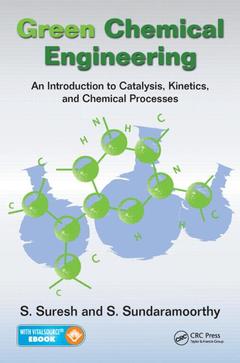Green Chemical Engineering An Introduction to Catalysis, Kinetics, and Chemical Processes
Auteurs : Suresh S., Sundaramoorthy S.

While chemical products are useful in their own right?they address the demands and needs of the masses?they also drain our natural resources and generate unwanted pollution. Green Chemical Engineering: An Introduction to Catalysis, Kinetics, and Chemical Processes encourages minimized use of non-renewable natural resources and fosters maximized pollution prevention. This text stresses the importance of developing processes that are environmentally friendly and incorporate the role of green chemistry and reaction engineering in designing these processes.
Focused on practical application rather than theory, the book integrates chemical reaction engineering and green chemical engineering, and is divided into two sections. The first half of the book covers the basic principles of chemical reaction engineering and reactor design, while the second half of the book explores topics on green reactors, green catalysis, and green processes. The authors mix in elaborate illustrations along with important developments, practical applications, and recent case studies. They also include numerous exercises, examples, and problems covering the various concepts of reaction engineering addressed in this book, and provide MATLAB® software used for developing computer codes and solving a number of reaction engineering problems.
Consisting of six chapters organized into two sections, this text:
- Covers the basic principles of chemical kinetics and catalysis
- Gives a brief introduction to classification and the various types of chemical reactors
- Discusses in detail the differential and integral methods of analysis of rate equations for different types of reactions
- Presents the development of rate equations for solid catalyzed reactions and enzyme catalyzed biochemical reactions
- Explains methods for estimation of kinetic parameters from batch reactor data
- Details topics on homogeneous reactors
- Includes graphical procedures for the design of multiple reactors
- Contains topics on heterogeneous reactors including catalytic and non-catalytic reactors
- Reviews various models for non-catalytic gas?solid and gas?liquid reactions
- Introduces global rate equations and explicit design equations for a variety of non-catalytic reactors
- Gives an overview of novel green reactors and the application of CFD technique in the modeling of green reactors
- Offers detailed discussions of a number of novel reactors
- Provides a brief introduction to CFD and the application of CFD
- Highlights the development of a green catalytic process and the application of a green catalyst in the treatment of industrial effluent
Comprehensive and thorough in its coverage, Green Chemical Engineering: An Introduction to Catalysis, Kinetics, and Chemical Processes
Introduction. Section I Kinetics, Catalysis and Chemical Reactors. Introduction to Kinetics and Chemical Reactors. Homogeneous Reactors. Heterogeneous Reactors. Section II Green Chemical Processes and Applications. Green Reactor Modelling. Application of Green Catalysis and Processes. References. Further Reading. Index.
Suresh Sundaramurthy is an assistant professor of chemical engineering at Maulana Azad National Institute of Technology, Bhopal, India. He holds a PhD from Indian Institute of Technology, Roorkee, India, in the area of environmental pollution control. He has held various research positions at a number of universities in India including Pondicherry University, Indian Institute of Technology Kanpur, and International Centre for Materials Science, JNCASR, Bangalore. His research interests are in the areas of separation processes, reactor design, adsorption, catalysis, waste utilization, and nanomaterials. He has written a number of research articles and books in his area of research.
Sundaramoorthy Sithanandam
Date de parution : 12-2014
Ouvrage de 511 p.
17.8x25.4 cm
Thèmes de Green Chemical Engineering :
Mots-clés :
Gas Side Mass Transfer Coefficient; Catalytic Wet Oxidation; Adsorption Of Dyes/Phenol Using Synthesized Zeolite And Waste Material; Pe Rc; Linear Equations By Regression; Catalytic WPO; Homogeneous Ideal Reactors; Catalytic Wet Air Oxidation; Chemisorption; Catalyst Pellet; Aspen Plus Simulation Of Rcstr Model; Spherical Catalyst Pellet; Catalytic Wet-Air Oxidation Processes; COD Reduction; Homogeneous Reactors; Residence Time; Chemical Reaction Engineering; Phase P2; Homogeneous Non-Ideal Reactors; Cod Removal; Green Reactor Modeling; Thiele Modulus; Order Irreversible Reaction; Wet Air Oxidation; Uidised Bed; NaOH Concentration; Bed Catalytic Reactor; Moving Bed Reactor; Batch Reactor Experiment; Feed Stock; dC Dr; Non-elementary Reaction; Fractional Conversion; Uidised Bed Reactor; Microwave Heating



